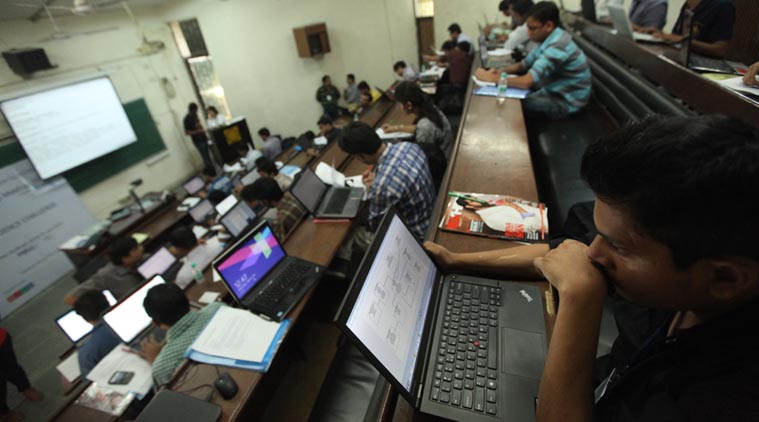Innovation, not eminence, is key
To be leaders in education, Indian institutions must evolve a new paradigm.

In India, the better institutions of higher education tend to prepare graduates for their first job or vocation. But this is of limited merit in a world where a person is expected to change vocations and re-skill herself six times over a career.
Higher education in India is in need of reform. In fact, higher education across the globe is failing to keep up with the changing demands of an unpredictable world. For Indian higher education, the moment presents a rare opportunity — inspiring and daunting in equal parts — to forsake efforts at incremental improvement, and instead leapfrog its global counterparts with learning that can keep pace with the evolving balance between humans, machines and the environment.
Humans and machines have co-existed at the physical level for millennia, dating back to the invention of the potter’s wheel in ancient Mesopotamia. Now, humans and machines are coming together at a cognitive level. The boundaries between the two are getting blurred. Our progress over the centuries has been driven by the human desire to conquer the environment, but we may now have gone too far. Indeed, more people are living in the world today than have lived and died since the dawn of humanity until well into the 20th century.
Nowhere are these inflexion points more pronounced than in India. We have one of the youngest, fastest growing, and largest workforces. That leaves us with a massive job creation challenge — an exercise further complicated by the fact that machines are replacing human jobs. There is also the matter of environmental sustainability of our activities. The quality of air, water and soil is teetering at the edge of habitability. These inflexion points are deeply inter-connected and constantly changing.
How might we prepare future generations for this new world?
By necessity, a new vision for education would have to represent the coming together of technology, humanities and ethics. It would weave together thought with action, left brain with right brain, arts with sciences and ultimately, the learnings of the past and present with preparedness for the future. This model of interwoven learning would represent a departure from other models of education anywhere in the world today.
In India, the better institutions of higher education tend to prepare graduates for their first job or vocation. But this is of limited merit in a world where a person is expected to change vocations and re-skill herself six times over a career. The recent trend towards liberal arts education is a step in the right direction, but falls short on many counts. It does not build comfort with technology, nor does it develop resilience. Learning must equip graduates to learn to learn.
But this is not enough either. Higher education should prepare students for life, not just a career. In a world of shortening attention spans and transactional relationships, students need to be given an opportunity to look deep inside to discover their sense of purpose. At the same time, individuals need to be cognisant of the role they play in society, and how their thoughts and actions impact the world. Finally, and most significantly, students need to learn to deal with the inevitable ethical challenges they will face.
How can an institution deliver these critical outcomes? If one were to break up, say, the undergraduate experience into modules, the foundation module would introduce students to ways of thought and expression, building on disciplinary knowledge in the social sciences, natural sciences, humanities, arts and literature. The core skills module would help students develop a set of life skills, including ethical reasoning, data science, design thinking and effective communication. The concentration module would permit them to deep dive into a chosen discipline, not merely for the sake of accumulating knowledge in that discipline, but to develop a deep sense of inquiry and to learn to solve problems. To be able to deliver all this, an institution would need to build porous boundaries between itself and the real world, where theoretical learnings from coursework are woven together with real-life situations and problems. Finally, rigorous research needs to bring together the cutting edge from various disciplines and connect them to form a holistic view. This would continuously feed learning, and connect research with teaching in a continuous loop to stay relevant.
Can Indian higher education truly leapfrog the world? Interwoven learning has to be implemented at an institutional level. The Government of India’s initiative to select Institutes of Eminence (IoE) is a step in the right direction. But India needs hundreds of institutes of eminence, not just six. (Full disclosure — Krea University is not one of the six). And these IoEs need to think beyond the current mandate of breaking into the top 500 global rankings within 10 years. This is an ambitious goal in itself, but one of incremental improvements. Leapfrogging will require a shift to innovative models of higher education. Further, the intent must be to provide a flexible regulatory environment so that, with or without the tag of “eminence”, institutes are encouraged to experiment.
While only a few institutes may establish proof-of-concept, the idea must be to have a constantly expanding pool. Scaling up will require time and government funding at a scale substantially higher than currently envisaged for the Institutes of Eminence initiative.
The writer is vice-chairman of Krea University, which had applied for the Institutes of Eminence tag





































No hay comentarios:
Publicar un comentario